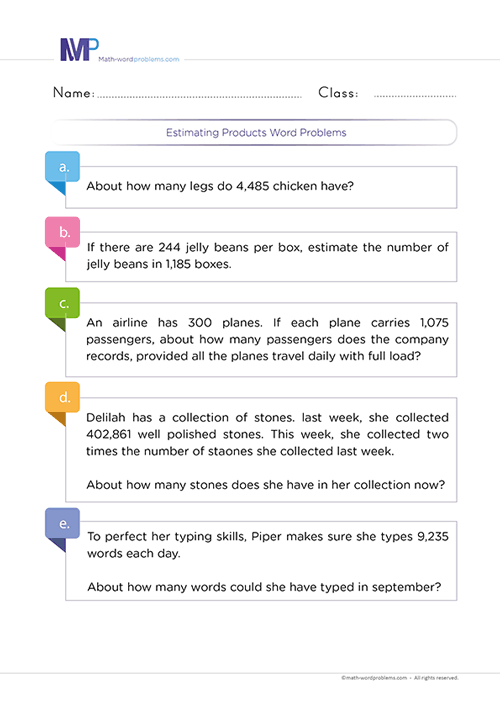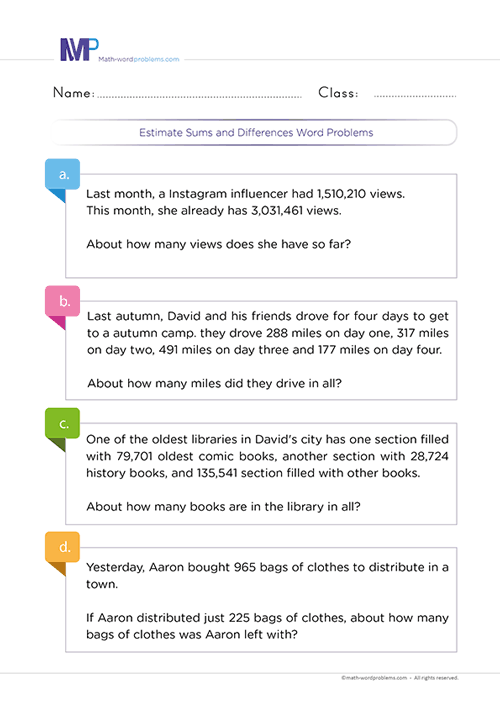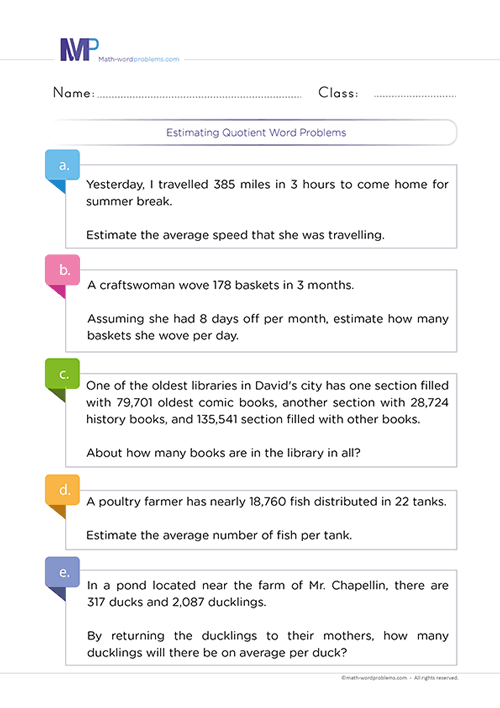 How to estimate products word problems
How to estimate products word problems
Here is a unique step-by-step guide on how to estimate product word problems. This guide will offer fifth graders the best procedure to follow while estimating products and solving word problems.
In addition, this guide will provide essential tips that will motivate kids to quickly understand the context of word problems and provide a solution to the problem. That way, learners can easily break down the problem into the required problem statement type, numbers, and equations.
However, this will enable 5th graders to see through the step-by-step procedure rather than just diving to provide the answer for the word problem.
Steps on how to estimate products word problems
Enhance your kids’ math skills with these steps on how to estimate product word problems below. This step-by-step structured process will easily engage kids’ minds into understanding what the word problem wants from them.
Also, with this resource, your kids will show a significant interest in always solving word problems, thereby improving their math problem-solving skills.
Above all, we have added some thrilling real-life examples for the kids to see how amazing these steps work.
Step 1: IDENTIFY THE PROBLEM
To identify the problem, start by finding exactly what the problem wants you to solve. In other words, is the problem an addition, a subtraction, a multiplication, or a division problem? You can do this by looking for important keywords in the word problem.
- For instance, if it is estimating whole numbers involving multiplication word problems, you will surely come across one of the following keywords in the word problem: - times, multiplied by, product, product of, factor, of, multiply, times, multiple, double, triple, groups, by, twice, area, equal groups, every, in all, total, increased by, as much, each, lots of, groups of, per, etc.
- Another way to know if a word problem requires you to estimate is by looking out for the words: “about …” and “estimate …” in a word problem.
In addition to this, you have to take note of the following:
- Know and understand your place values.
- Know when to round up or down.
Note: One key Element for learners to understand is that they should not always rely on keywords alone. That is to say; the same keyword can have different meanings in different word problems.
For this reason, we reiterate on the importance of reading the question very carefully to understand the situation that the word problem is describing, then figure out exactly which operation to use
Step 2: STRATEGIZE OR GATHER RELEVANT INFORMATION
How will you solve or tackle the word problem?
One key thing you should remember is that each word problem may require a different format. Hence, the key points below will enable young math learners to tackle any format however it comes.
- From the keyword(s) in the word problem, you will know if you need to add, subtract, multiply or divide.
- However, know that you must not rely only on keywords. Rather try to understand the situation that the problem is describing.
- Then, after knowing which operation you will perform, construct short expressions/sentences to represent the given word problem.
Step 3: SET UP AN EQUATION
Now, write down a numerical equation representing the information given in the word problem.
Step 4: PROVIDE A SOLUTION
From step 3 above, estimate and multiply the numerical equation. Always recall the unit of measurement, if any.
There are a few steps to follow when estimating or rounding.
- Firstly, look at the number to the immediate right of the digit to be rounded.
- If that number is 0−4, keep the digit (to be rounded) unchanged, then replace all numbers to the right of that digit with 0.
- But if that number is 5−9, increase the digit (to be rounded) by 1, then replace all numbers to the right of that digit with 0.
Step 5: CHECK YOUR WORK
Finally, check if your answer makes sense. For instance, estimate the answer and see if it is close to what you expected. However, if the answer is not what you expected, go back to step one and start all over again.
Examples on how to estimate products word problems
Example one
Step 1: Frist, the important numbers here are 852 and 12. The keyword(s) found in the word problem is “times” and “about.”
Step 2: Next, how will you solve the problem? The keyword in the word problem calls for you to use a multiplication operation. Also, the phrase “about” shows that we have to estimate.
Now, create short expressions/sentences to represent the given word problem.
- Number of stamps he collected last year = 852
- The number of stamps he collected this year than last year = twelve times the number of stamps he collected last year.
- Therefore, the actual estimated number of stamps that he has collected this year = the estimated number of stamps he collected last year × the estimated number of stamps he has collected this year than last year
Step 3:Now, write down a numerical expression to represent the bolded sentence in step 2 above to solve this word problem:
852 × 12 = ?
Step 4: From Step 3 above, estimate and multiply the whole numbers by following the steps below.
- Firstly, look at the number to the immediate right of the digit to be rounded.
- Then, if that number is 0-4, keep the digit to be rounded unchanged and replace all numbers to the right of that digit with 0
- But if that number is 5-9, increase the digit to be rounded by 1 and replace all numbers to the right of that digit with 0.
- Another key thing to remember is the unit of measurement, if any.
**Now, since one of the factors has only two digits, you have to round it to the nearest tens. Hence, you will also round the other factor to the nearest tens.
Note that we do this only in cases where the rounding place for each number is not specified. **
852 × 12 ≈ 850 × 10 = 8,500.
So, he has collected about 8,500 this year.
Step 5: Finally – Ask yourself this question. “Does my answer make sense?” If “YES,” you are done. If “NO,” go back to step 1 and start all over again.
Example two
Step 1: Frist, the important numbers here are 452 and 85. The keyword(s) found in the word problem is “about how many.”
Step 2: Next, how will you solve the problem? From the situation the problem is describing and the keyword(s) found in the word problem, you need to perform a multiplication operation. Also, the phrase “about” tells you that you have to estimate.
Now, create short expressions/sentences to represent the given word problem.
- Number of jars of marbles he bought today = 85
- Number of marbles in each jar = 452
- The number of marbles he bought today = the number of jars of marbles he bought x the number of marbles in each jar.
- Therefore, the estimated number of marbles he bought today = the estimated number of jars of marbles he bought today × the estimated number of marbles in each jar
Step 3:Then, write down a numerical equation for each bolded sentence in step 2 above to solve this word problem:
452 × 85 = ?
Step 4: From Step 3 above, estimate and multiply the whole numbers by following the steps below.
- Firstly, look at the number to the immediate right of the digit to be rounded.
- If that number is 0−4, keep the digit to be rounded unchanged, then replace all numbers to the right of that digit with 0
- But if that number is 5−9, increase the digit to be rounded by 1 and replace all numbers to the right of that digit with 0.
- Another key thing to remember is the unit of measurement, if any.
**Now, since one of the factors has only two digits, you have to round it to the nearest tens and also round the other factor to the nearest tens.
This is done only in cases where the rounding place for each number is not specified. **
452 × 85 ≈ 450 × 90 = 40,500
So, he bought about 40,500 marbles today
Step 5:Finally, check your work – Ask yourself this question. “Does my answer make sense?” If “YES,” you are done. If “NO,” go back to step 1 and start all over again.






